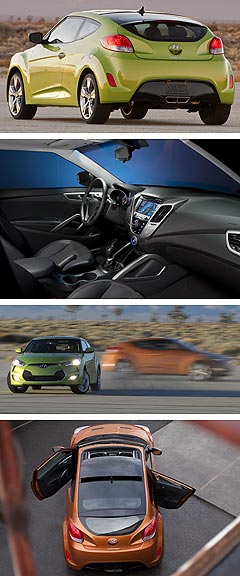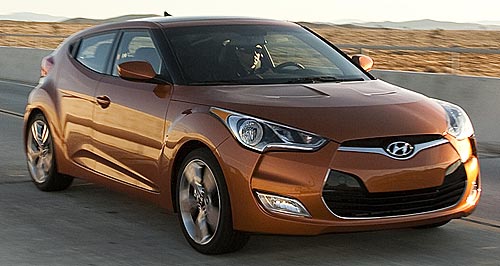Make / Model Search
Future models - Hyundai - VelosterHyundai’s radical Veloster coupe hitsOpera House: Hyundai's Veloster makes its first public appearance outside of a motor show, with some musical accompaniment. Sydney hosts Hyundai’s first public showing of Veloster outside a motor show21 Mar 2011 SYDNEY’S Circular Quay and world-famous Opera House were the backdrop for the first public showing of Hyundai’s radical, concept-made-reality Veloster coupe outside of a motor show, with two production-ready examples on display beside the glittering harbour of Australia’s oldest city. Hyundai announced that its Accent-based Coupe will go on sale in Australia by the end of this year, debuting for the brand both an all-new 1.6-litre direct injection petrol engine and six-speed dual-clutch transmission. And, having decided that only vehicles specifically developed with the European market in mind will receive an i-prefixed numerical designation, the South Korean automotive giant revealed the Veloster will retain the name from the original concept that debuted at the Seoul show in 2007 rather than take on the expected i15 moniker. No exact launch date, pricing or specification levels were announced, but the world’s fifth-largest car company said Australian-delivered Velosters will have their suspension and steering tuned to suit local road conditions and high levels of safety kit, including a sophisticated new stability control system and a “full complement of airbags”. Hyundai said Veloster will offer value for money and be targeted at the youth market, but could not yet provide any early indications of price.  The Veloster challenges the conventional wisdom that symmetry is beauty, for it is wilfully asymmetrical, having two doors on the passenger side and a single driver’s door that is longer than the corresponding passenger-side door. Despite this, because it is difficult to view both sides of the car at once and the rear passenger door has an Alfa-style concealed door handle, the design makes sense in the flesh. The Veloster challenges the conventional wisdom that symmetry is beauty, for it is wilfully asymmetrical, having two doors on the passenger side and a single driver’s door that is longer than the corresponding passenger-side door. Despite this, because it is difficult to view both sides of the car at once and the rear passenger door has an Alfa-style concealed door handle, the design makes sense in the flesh.Unlike the Mini Clubman, which also has an asymmetrical door design – albeit an RX-8 style rear-hinged ‘suicide’ door that requires the driver’s door to be opened first – the Veloster’s conventionally-hinged individual doors will be re-engineered for right-hand drive markets. Hyundai claims this bold and unusual layout, which attempts to combine the style and excitement of a coupe with the practicality of a hatch, perfectly embodies its new corporate slogan of “new thinking, new possibilities”. The two Korean-spec Velosters were presented to the media outside the Opera House as part of Hyundai’s sponsorship of the YouTube Symphony Orchestra event, the grand finale of which was held on Sunday night. Several women at the event expressed enthusiasm for the coupe, describing it as sexy, funky, sporty and sleek while praising the practicality of the rear door and a more spacious than expected interior. While the Veloster exhibits its own brand of Hyundai’s ‘fluidic sculpture’ design language at the front, from the side and rear it recalls the Alfa Romeo Brera and Renault Megane RS250. Short overhangs and muscular-looking curves further add to the suggestion of sporting intent. The Veloster is strictly a four-seater, with a cup-holder space between the rear seats. A rear passenger sitting behind the driver must slide across the bench to exit, making sure that on both entry and exit they are not obstructed by a beverage container. We found the rear packaging was better than expected. With the front seats set in a comfortable position for occupants of over 180cm in height, similarly sized rear passengers have just enough legroom, although knees do brush the backrest of the seat in front. However, headroom for people of this height is an issue. While the display car’s three-quarter length glass roof liberates about an inch of extra space for front occupants, a lower ceiling in the back required tall passengers to duck. You could find extra space below the glass of the tailgate if you sit back but run the risk of headbutting the roof lip under sharp braking or in a collision. Up front, the driver is faced with an instrument pack said to draw inspiration from high-performance sports motorcycles, but the link seems tenuous when compared with the Barina Spark’s dial pod. The dashboard is pure modern Hyundai with blue backlighting while a large central engine start/stop button makes the V-shaped centre stack look like an exclamation mark. Dashboard materials were the usual Hyundai fare in that they are better to look at than to touch, although the comfortable, supportive seats are upholstered in pleasantly supple leather with a quality feel. The spacious glove compartment showed how close the display vehicle was to the showroom end-product by revealing a packet containing an auxiliary audio-visual input cable. The driving position felt natural and the chunky aluminium pedals featured a fantastic floor-hinged throttle, but all-round visibility suffered from thick internal B- and C-pillars as well as the split glass tailgate with its high waistline. The Hyundai badge on the tailgate sits on a raised disc that incorporates a semi-circular handle, with the effect of forming a smiling face that grins at following traffic. The boot was deep but would struggle to accommodate the cliched two golf bags side-by side and a very high lip means loads must be lifted before placing them inside. The Veloster’s ‘Gamma’ powerplant, a 1.6-litre four-cylinder petrol unit with direct injection and continuously variable valve timing for both intake and exhaust, will be the brand’s smallest direct-injection engine. In addition to the injection and valve-timing technology, Hyundai claims the engine’s electronic throttle control, roller timing chain, variable induction and use of anti-friction coatings will combine to provide highway fuel economy of 5.9 litres per 100km. Final performance figures are yet to be confirmed, but Hyundai estimates the Gamma engine will churn out 103kW at 6300rpm and 167Nm of torque at 4850 rpm. It will be mated to a six-speed manual transmission, with the option of Hyundai’s first dual-clutch automatic, which was developed in-house and is said to offer up to six percent better fuel consumption and up to seven percent quicker acceleration. Veloster sits on a 2650mm wheelbase, is 4220mm long, 1790mm wide and is claimed to weigh just 1172kg in manual form. Sharing underpinnings with the new Accent sedan – which is confirmed for Australia in Q3 to sit alongside the i20 hatch as a ‘premium light’ entry – the Veloster gets MacPherson strut front suspension and a torsion beam rear end.  Read more29th of December 2010  Detroit show: Hyundai Veloster almost hereRoad-ready version of Hyundai’s affordable new Veloster coupe to bow in a fortnightAll future models Alfa Romeo Alfa Romeo Abarth Abarth Alpine Alpine Alpina Alpina Audi Audi Aston Martin Aston Martin BMW BMW Bentley Bentley Chery Chery Brabham Brabham Chrysler Chrysler Chevrolet Chevrolet Cupra Cupra Citroen Citroen DS DS Dodge Dodge Fiat Fiat Ferrari Ferrari Foton Foton Ford Ford Great Wall Great Wall FPV FPV Haval Haval GWM GWM Honda Honda Holden Holden Hummer Hummer HSV HSV Infiniti Infiniti Hyundai Hyundai Jaguar Jaguar Isuzu Isuzu Kia Kia Jeep Jeep Land Rover Land Rover Lamborghini Lamborghini Lexus Lexus LDV LDV Mahindra Mahindra Lotus Lotus Mazda Mazda Maserati Maserati Mercedes-AMG Mercedes-AMG McLaren McLaren MG MG Mercedes-Benz Mercedes-Benz Mitsubishi Mitsubishi Mini Mini Opel Opel Nissan Nissan Peugeot Peugeot Pagani Pagani Proton Proton Porsche Porsche Renault Renault Ram Ram Rover Rover Rolls-Royce Rolls-Royce Skoda Skoda Saab Saab SsangYong SsangYong Smart Smart Suzuki Suzuki Subaru Subaru Toyota Toyota Tesla Tesla Volvo VolvoVeloster pricingMotor industry news |
Click to shareHyundai modelsResearch Hyundai All future models Alfa Romeo Alfa Romeo Abarth Abarth Alpine Alpine Alpina Alpina Audi Audi Aston Martin Aston Martin BMW BMW Bentley Bentley Chery Chery Brabham Brabham Chrysler Chrysler Chevrolet Chevrolet Cupra Cupra Citroen Citroen DS DS Dodge Dodge Fiat Fiat Ferrari Ferrari Foton Foton Ford Ford Great Wall Great Wall FPV FPV Haval Haval GWM GWM Honda Honda Holden Holden Hummer Hummer HSV HSV Infiniti Infiniti Hyundai Hyundai Jaguar Jaguar Isuzu Isuzu Kia Kia Jeep Jeep Land Rover Land Rover Lamborghini Lamborghini Lexus Lexus LDV LDV Mahindra Mahindra Lotus Lotus Mazda Mazda Maserati Maserati Mercedes-AMG Mercedes-AMG McLaren McLaren MG MG Mercedes-Benz Mercedes-Benz Mitsubishi Mitsubishi Mini Mini Opel Opel Nissan Nissan Peugeot Peugeot Pagani Pagani Proton Proton Porsche Porsche Renault Renault Ram Ram Rover Rover Rolls-Royce Rolls-Royce Skoda Skoda Saab Saab SsangYong SsangYong Smart Smart Suzuki Suzuki Subaru Subaru Toyota Toyota Tesla Tesla Volvo VolvoVeloster pricingMotor industry news |










Facebook Twitter Instagram